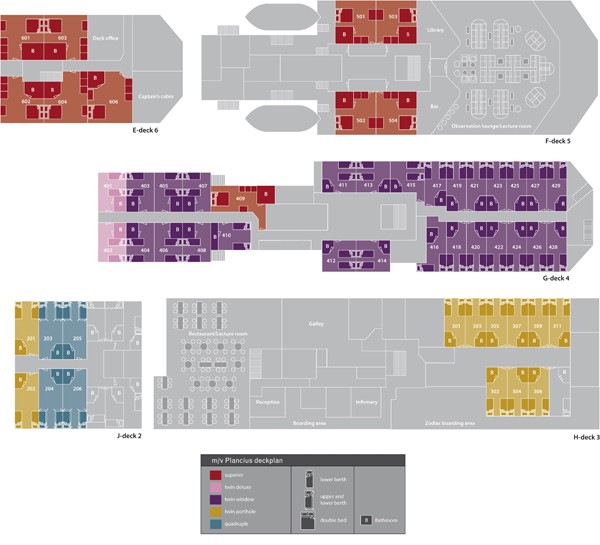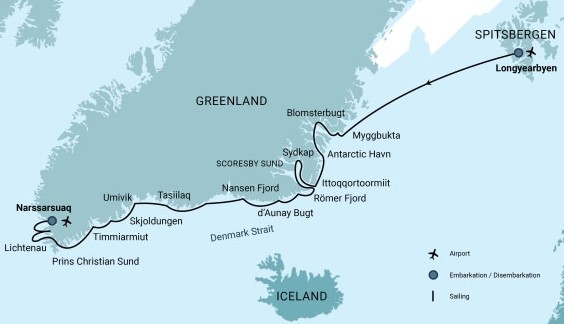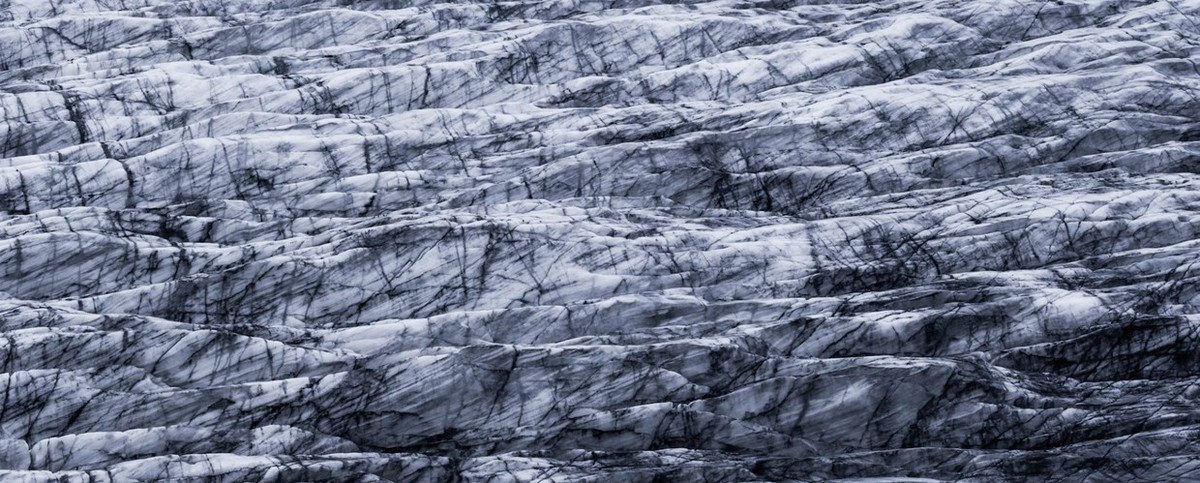
East Greenland is among the most remote and least populated areas of the Arctic, a wild place of dramatic fjords, small Inuit settlements, and ancient remains from Viking and Thule cultures. Sail and explore the coastlines of this ruggedly beautiful region, enjoying its impressive rock formations and colossal icebergs while keeping an eye open for Arctic wildlife.
- Explore the remote fjords and shorelines of East Greenland, seeing remains from Thule, Norse, and Viking cultures in addition to Arctic wildlife
Prices quoted here are often dependent on currency fluctuations. Please check with (01432 507450 or info@small-cruise-ships.com) for the very latest price, which may well be cheaper than the one advertised here.

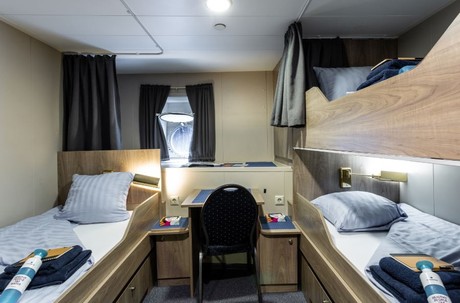
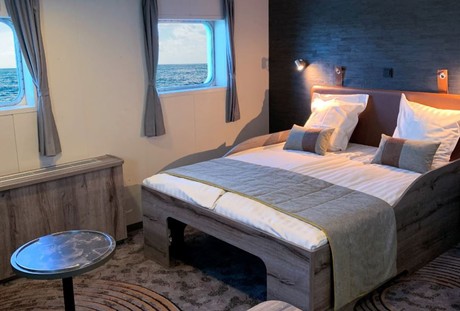
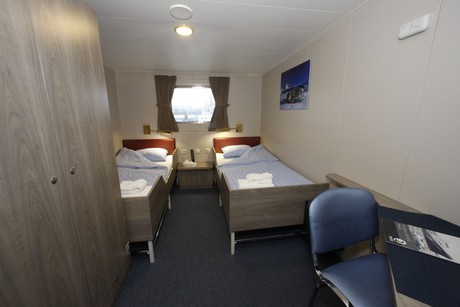
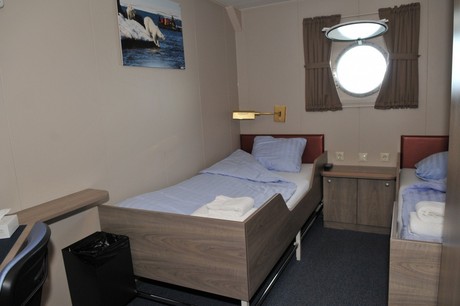

The adventure begins in Longyearbyen, the administrative center of Spitsbergen. Enjoy strolling around this former mining town, whose parish church and Svalbard Museum make for fascinating attractions. Though the countryside appears stark, more than a hundred species of plant have been recorded here. In the early evening the ship sails out of Isfjorden, where we might spot the first minke whale of the voyage.
We may eventually see the jagged edge of the east Greenland sea ice flashing into sight, depending on the conditions. Keep watch for whales and migrating seabirds.
As we approach Greenland, we may sail through the sea ice into Foster Bay and land at Myggebugten. Beyond the old hunters’ hut where Norwegian trappers once hunted for polar bear and Arctic fox, there is a sprawling tundra populated by musk oxen as well as geese floating the small lakes. From here we sail through Kaiser Franz Josef Fjord, surrounded by towering mountains and bright interior icebergs. An alternate route is Sofia Sound, a narrower waterway.
We arrive at Teufelschloss (Devil’s Castle), a mountain with layered geology. On the other side of the fjord is Blomsterbugt and the intended landing site. In the afternoon we head into Antarctic Sound, where we find the islands of Ruth, Maria, and Ella. Maria is the most likely spot for a landing.
The first half of the day we spend in Antarctic Havn, an extensive valley where you can spot groups of musk oxen. At this time of year, the sparse vegetation is dressed in the fiery colors of autumn.
Today we reach Scoresby Sund, sailing along the glaciated Volquart Boons Kyst. You may also enjoy a Zodiac cruise past one of the glacier fronts, along with a visit to the basalt columns and ice formations of Vikingebugt. We continue along the east coast of Milne deeper into the fjord.
In the morning we encounter colossal icebergs, some over 100 meters (328 feet) high and more than a kilometer long. Most of them are grounded, as the fjord is only about 400 meters deep (1,312 feet). We then land near Sydkap, with fine views of Hall Bredning and a good shot of seeing Arctic hares. Later we will land at Satakajik and see the remains of Thule dwellings.
Today we make a tundra landing on Liverpool Land, in Hurry Inlet. The afternoon stop is Ittoqqortoormiit, the largest settlement in Scoresby Sund at about three hundred inhabitants. At the post office you can buy stamps for your postcards or just stroll around to see the sled dogs and drying skins of seals and musk oxen. In the afternoon we sail south, passing the picturesque landscapes of the Blosseville Coast.
Our next stop is Stewart Island, an important hunting area for the people of Scoresby Sund. There are beautiful remains of Thule houses to be seen here. Rømer Fjord and Turner Sound, meanwhile, give us the opportunity to sail far inland, as they have no glacier front at their head and are not clogged with ice. This also provides us good hiking opportunities.
Sailing south along the East Greenland coast, we enter several fjords competing in beauty: d’Aunay, Nansen, and possibly either Ikersuaq or Kangertitsivaqmiit. Most of these fjords have glacier front at the head, but any of them can offer us a chance to see polar bears.
Tasiilaq, once known as Angmagssalik (about 2,000 inhabitants) is our next port of call. This charming town is the center of East Greenland, boasting a museum where you can learn about the colorful local history of this incredibly remote area.
We next sail south to land at Umivik, where the explorer Fridtjof Nansen ascended the Greenland ice sheet. Here you may even be able to walk a short distance in his steps.
Today we circumnavigate Skjoldungen through one of the most spectacular fjords of southeast Greenland, then land at Qornoq to see houses from the Thule culture. We will then visit Mariedal and a beautiful valley where Greenlanders used to collect berries in autumn.
Moving on to Timmiarmiut, we see an abandoned Greenlandic settlement and will possibly sail into the fjord. Polar bears have sometimes been spotted here in the past. As an alternative, we may visit Igutsait to the south.
Our westward passing of the Prins Christian Sund is surrounded by mountains of over 1,000 meters (3,300 feet) and is one of the highlights of the voyage. We may make a landing at Svaerdfiskens Havn or in the evening at Ikigait, once known as Herjolfsnes, a former Norse settlement.
Today we reach Lichtenau, a lovely though nearly deserted Greenlandic village, where the Herrnhuters had a mission in the 18th century and where some of their large German-style buildings still remain. We will then try to get to Uunartoq, where we can bathe in a large hot spring surrounded by icebergs. Across at Vagar, we find the remains of a Norse homestead.
In Eriksfjord we land at Ittileq, in a bay from which we can walk 4 km (2.5 miles) down a road to Igaliku (Gardar). In this small Greenlandic village, we can see the remains of a 13th-century Norse church, along with other ruins. Then in the afternoon, we plan to visit Bratthalid, the base of Erik the Red. This is a sub-Arctic area with birch trees, agriculture, and cattle. Later that evening, we arrive at Narssarsuaq for the final night of our voyage.
From the WW2-era airport of Narssarsuaq, we fly back to Copenhagen. Though our adventure has come to an end, we take home memories that will accompany us wherever the next adventure lies.
All itineraries are for guidance only. Programs may vary depending on ice, weather, and wildlife conditions. Landings are subject to site availabilities, permissions, and environmental concerns per AECO regulations. Official sailing plans and landing slots are scheduled with AECO prior to the start of the season, but the expedition leader determines the final plan. Flexibility is paramount for expedition cruises. The average cruising speed of our vessel is 10.5 knots.
Plancius
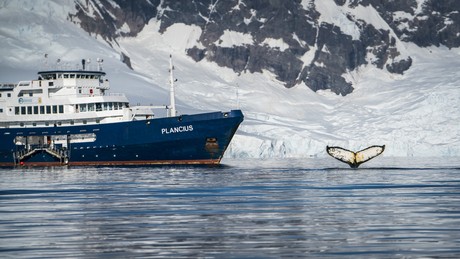
| Length | 89 metres |
|---|---|
| Speed | 10-12 knots |
| Crew | 37 |
| Expedition staff | 8 |
| Doctor | 1 on board |
M/V "Plancius" was built in 1976 as an oceanographic research vessel for the Royal Dutch Navy and was named "Hr. Ms. Tydeman". The ship sailed for the Dutch Navy until June 2004 when she was converted into an expedition cruise ship..The vessel was completely rebuilt as a 114-passenger vessel in 2009 and complies with the latest SOLAS-regulations (Safety Of Life At Sea). M/v "Plancius" is classed by Lloyd's Register in London and flies the Dutch flag.
"Plancius" accommodates 114 passengers in 53 passenger cabins with private toilet and shower in 4 quadruple private cabins, 39 twin private cabins (ca. 15 square meters) and 10 twin superior cabins (ca. 21 square meters).All cabins offer lower berths (either two single beds or one queen-size bed), except for the 4 quadruple cabins (for 4 persons in 2x upper and lower beds).The vessel offers a restaurant/lecture room on deck 3 and a spacious observation lounge (with bar) on deck 5 with large windows, offering full panorama view.
Plancius has large open deck spaces (with full walk-around possibilities on deck 3), giving excellent opportunities to enjoy the scenery and wildlife. She is furthermore equipped with 10 Mark V zodiacs, including 40 HP 4-stroke outboard engines and 2 gangways on the starboard side, guaranteeing a swift zodiac operation.M/v "Plancius" is comfortable and nicely decorated, but is not a luxury vessel. Our voyages in the Arctic and Antarctic regions are and will still be primarily defined by an exploratory educational travel programme, spending as much time ashore as possible.
The vessel is equipped with a diesel-electric propulsion system which reduces the noise and vibration of the engines considerably. The 3 diesel engines generate 1.230 horse-power each, giving the vessel a speed of 10 - 12 knots. The vessel is ice-strengthened and was specially built for oceanographic voyages.M/v "Plancius" is manned by 17 nautical crew, 19 hotel staff (6 chefs, 1 hotel manager, 1 steward-barman and 11 stewards / cabin cleaners), 8 expedition staff (1 expedition leader and 7 guides-lecturers) and 1 doctor.
Ice class: Plancius was built for Ice conditions. To reach these ice-conditions she has a strengthened bow and stern. The hull is thicker and the whole construction on the waterline of the vessel is reinforced by using extra frames. Where the normal frame spacing is 65cm, we have on the bow-line and stern also frames in between so there the frame spacing is approx 30cm. Because Plancius was built to do surveys she has a special six blade bronze propeller, the shape of the propeller makes Plancius a very silent ship. Plancius has a Lloyds class notation 100A1 Passenger ship, Ice Class 1D at a draught of 5 meters (which is our waterline).Vessel Type: Expedition
